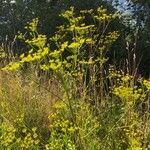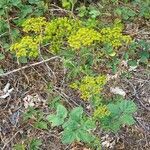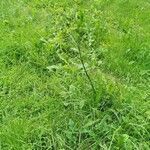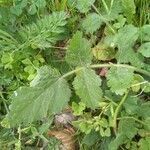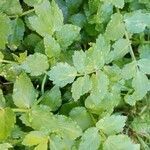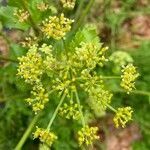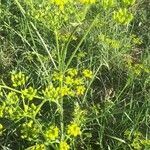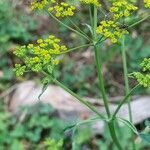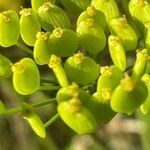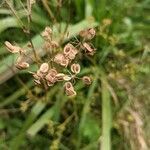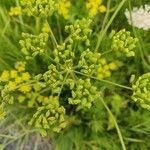Taprooted biennial to 1.5 m; lfls 5–15, oblong to ovate, 5–10 cm, serrate or lobed, or, in robust pls the larger ones even divided into 2–several lfls; rays 15–25; umbel 1–2 dm wide; fr 5–7 mm; 2n=22. Native of Eurasia, long cult. and thoroughly established as a weed in waste places, fields, and along roadsides throughout most of N. Amer. The common cult. parsnip and similar wild plants with smaller roots are considered conspecific, and some of the wild plants may actually be recent escapes.
Main root fusiform. Stems angular and strongly grooved. Leaves pinnate, leaflets 2-13 by 1-5 cm, oblong-ovate, often 3-lobate to 3-partite, irregularly crenate. Compound umbels terminal on the stems and its branches; peduncles 3-7 cm; rays 5-12, 1-4 cm; pedicels 10-20, 2-7 mm; involucres and involucels none or 1-2. Calyx teeth none. Petals yellow, with inflexed tips. Mericarps inclusive the ¼-½ mm broad marginal wing 5-7 by 4-5 mm, broad-elliptic.
Plants stout, 1–1.6 m high. Root yellowish-brown, up to 30 × 10 cm, fleshy becoming fibrous with age. Basal petioles ca. 13 cm, sheathing; leaf blade oblong-ovate, 20–30 × 10–16 cm, pinnate; pinnae oblong to ovate, 5–8 × 2.4–4 cm. Peduncles stout, 5–12 cm; rays 10–30, 3–8(–10) cm, unequal; umbellules ca. 1 cm across, ca. 20-flowered; pedicels 5–10 mm, slender. Petals 1–1.2 × ca. 1 mm. Fruit 5–6 × 4–6 mm. Fl. and fr. Jun–Aug. n = 11.
A herb with long thickened tap root. The stems are angular and have grooves along them. The leaves are divided. The ones near the base have 5-11 lobes. These are oval and have teeth along the edge. The thickened root is yellowish white. The taproot can be 3 m long. Wild parsnip grows in some temperate places. It has a very strong parsnip smell. It can be used as food.
Biennial herb, up to 2 m high. Stems hollow, furrowed. Leaves large, pinnate; leaflets ovate, acute, sometimes lobed, margins irregularly toothed. Flowers yellow. Flowering time Nov.-Jan. Fruit dorsally compressed, virtually orbicular, with marginal wings; vittae not as long as fertile section of mericarp.
Biennial herb. Flowering stems up to 2 m high; erect. Leaves radical and cauline, compound; blade pinnate with 7-9 ovate, toothed or lobed leaflets. Flowers: involucre 0; greenish yellow; Sep.-Mar.
Biennial herb, up to 1 m high. Leaves pinnate with 7-9 ovate, toothed or lobed leaflets. Flowers greenish yellow.
